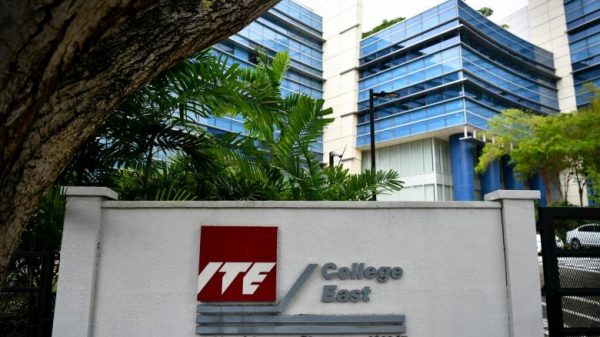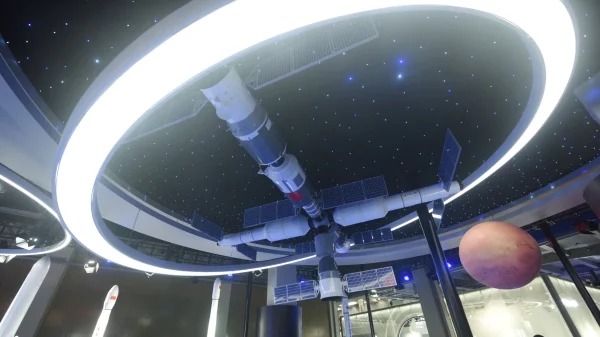
A flying car could allow us to get from point A to B, exploring the skies while never sitting in traffic.
This technology is no longer the stuff of fantasy. Numerous companies around the world are racing to make theirs available.
Canada’s Marcus Leng leads one of them.
“I think we’ve all had dreams of complete three-dimensional freedom,” said Leng, who is the CEO of Opener, a company developing a personal aerial vehicle.
As a young boy walking to school, he would wonder if there would ever be an aircraft that you could just jump in “and be able to take off vertically and fly wherever you wanted.”
He started designing and building prototypes in his basement in the small community of Warkworth, Ont.
Read more:
Ground-breaking flying taxi cruises through Paris
“I think our house became a factory,” he recalls.
“The basement was used for basically doing all the structure work … and the kitchen was basically used for manufacturing motors,” he told Global’s current affairs show, The New Reality. “We used to bake the motors in the oven. Boy, would that stink.”
It took over a year for him to fly his first proof-of-concept vehicle in his front yard.
“I found myself eventually at the end of our driveway and my friends and neighbours … were behind a barrier of cars that we had set up,” Leng said.
Marcus Leng flying BlackFly. Photo: Opener.
Opener
“And I figure, just like in skiing, I’ll do a skidding turn in front of them. All went very well, except during the skidding turn, the edge of the wing made contact with the lawn … but the propulsion systems reacted so fast that it basically created this long divot as it scraped through grass without the aircraft losing any control.”
Using eVTOL, which stands for electric-powered vertical takeoff and landing, Leng said he was able to produce a vehicle that doesn’t need a runway to get off the ground.
It’s called BlackFly. Some people often refer to it as a flying car. Leng calls it a personal aerial vehicle designed to fit one person.
Read more:
Flying car completes intercity test flight in Slovakia
Anyone up to six feet six inches and weighing 200 pounds or less can use it.
It has a joystick, can fly in -20 Celsius weather, and operate in about 32 km/h winds.
“In the United States, which is our primary market, we have very serious weight restrictions. So, the American vehicles have a 20-plus mile (32 km) range for an operator that’s 200 pounds,” Leng said.
“In Canada, we don’t have those weight constraints and also we don’t have speed constraints,” said Leng, who in 2014 relocated the majority of his operations to Palo Alto, Calif.
One of the key features about BlackFly is you don’t need a pilot’s licence to fly it.
According to Leng, a potential owner would have to complete a training course and be at least 18 years old.
“The nice thing about our vehicle is (that in) both the United States and Canada (it’s) classified as an ultralight aircraft,” he said. “In Canada, you require an ultralight licence, which is relatively easy and straightforward to obtain.”
In order to fly it, you need to take a short training course.
“I think the most unique thing is that I can be an operator, you can be an operator … in the course of about two days and a few hours of simulation how to safely fly this aircraft,” said Kristina Menton, who is the director of operations, flight testing and propulsion lead at Opener.
“That is something that is exceptionally novel and really incredible — to be able to give that type of experience of three-dimensional flight to regular people.”
Kristina Menton, director of operations at Opener, flying BlackFly.
Opener
She said the aircraft is almost exclusively made from carbon fibre, including the wings, fuselage and propellers. It’s electric, and therefore emissions-free.
“We have autoland features. So basically, when you get close to the ground, the aircraft will take over,” Menton said.
Canadians who help make BlackFly … fly
Menton has been working on BlackFly for years. When she first signed on with the company, she had no idea what product she’d be working on.
“I first met Marcus on a phone call the day before my last exam of university. He was looking to hire two mechanical engineers. At the time, the company was completely in stealth mode and he wasn’t able to say what the product was, who the investors were, really any of the technical details,” Menton told Global News.
“But I could get from the phone call that it was a pretty exciting and innovative opportunity and decided to take the leap to jump on board.”
She wasn’t the only one who took the leap. Eleanor Li, Menton’s classmate at the University of Toronto in mechanical engineering, did too. She joined Opener and moved to Silicon Valley without knowing the project she was hired to work on.
“Marcus basically came along and said, ‘Oh, we’re making this huge carbon epoxy part. Do you want to be part of our team?’ And I just said, ‘Yes, yes, here I am,’” said Li, who is now the plant manager at Opener.
Eleanor Li, plant manager at Opener, in a flight simulator at the company headquarters in Palo Alto, Calif.
Global News
For years, Leng had been secretly working on his invention while recruiting.
It wasn’t until 2018 that he started letting the world get a glimpse of BlackFly.
In July 2021, Li, Menton and Leng flew Blackfly at the Experimental Aircraft Association AirVenture show in Oshkosh, Wisc. The annual event can bring in hundreds of thousands of spectators.
“The flight is incredible. You have a panoramic view of anywhere,” said Li. “I told this to a few people at Oshkosh: when you’re in the aircraft, you feel like you are the aircraft and the aircraft is you.”
The team is working hard to make the aircraft available to consumers soon.
But first adopters will only be able to fly in rural areas. BlackFly is not allowed to go over built-up areas.
Leng is keeping the price tag to himself, but he believes as the industry advances, BlackFly will become more accessible to people.
“Our objective for next year is to produce 260 vehicles. But the ultimate goal is to be producing tens of thousands of these at a price that would be in line with an SUV,” he said.
—
See this and other original stories about our world on The New Reality airing Saturday nights on Global TV, and online.













































